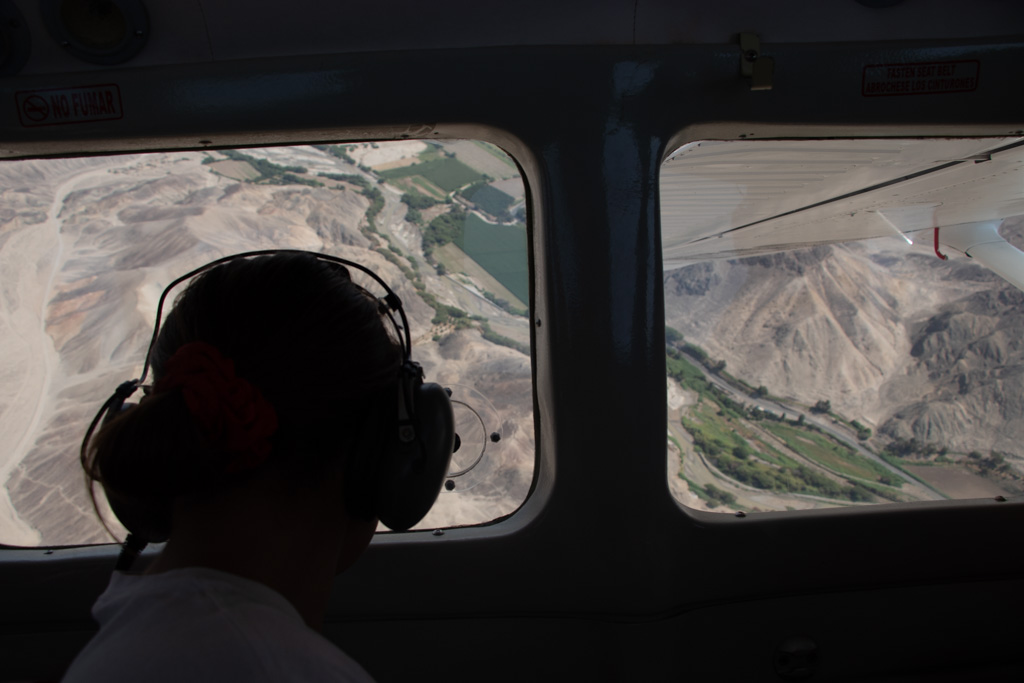A couple of things the kids haven’t written about or that got lost in the drive through Peru.
We did and overflight of the Nazca lines in Peru, but I couldn’t get the kids to write about it. I think it was the kids’ first time in a small plane (A Cessna 207, for various reasons related to getting ready for the trip and weather they still haven’t flown with me as pilot.) Audrey enjoyed it, Sydney wasn’t wild about the steep banking the plane did to let us see the lines. The lines are impressive, especially when contrasted with what they look like from the ground. Up close, they’re barely visible, being both thin and only slightly less rocky than the surrounding landscape.



The other cool thing in Nazca was a Necropolis: apparently grave robbers had looted the graves of the Nazca people and left bones and mummies strewn about. The graves have been restored, complete with mummies, and set up as an archeological site. Mummification was fairly common in Peru, from pre-Inca times to the conquest, and at least in some cultures mummies remained part of daily life. We saw many, many mummies in Peru.


To get to Machu Picchu, you have to take a train or hike in to the town of Agua Calientes, then take a bus up to the site. The lack of road connection makes Agua Calientes one of the nicest Peruvian towns we went to, as there were no Peruvian drivers or mototaxis to threaten your safety. The main street, however, does have a rail line going through it, and several trains pass through daily. This makes for some fun times walking down the street. Sometimes it’s a full train, sometimes just a locomotive, always awesome.

Peru seems to occasionally erupt into protests, and apparently in some of the recent ones the protesters targeted toll booths. We found the first 4 or 5 tool booths we went through were abandoned, and upon closer inspection we noticed they looked like they had been torched. Indeed, it turns out that some people were angry about the tolls so they set fire to the toll booths. It saved us some money, I guess, but given the state of their roads we would have been happy to give them the ten or so dollars for road maintenance.

We’re in Ecuador, and I am glad to no longer be driving in Peru. I’ve driven in Nigeria, and had plenty of time riding as a passenger in China, and Peru is much worse. The roads are bad; not in a uniformly bad way, but in a mostly-good-drive-80-kph-oh-wait-there’s-a-pothole/boulder/landslide/missing-section-of-pavement way. Sometimes in the mountains all of this is also happening in a cloud or thick fog. It’s exhausting work, and that’s when there aren’t other drivers around. Peruvian drivers are near-suicidal, with plenty of smashed cars along the way to testify to the folly of overtaking in blind corners. Finally, the roads are also used by little mototaxis or tuktuks, which drive slowly but erratically, but take up lots of space (especially if driving three-abreast), causing trucks to attempt overtakes, etc. Peru 8B was actually one of the more relaxing roads because of the lack of other traffic on the road. Ecuador has so far been much better.



4 Responses
Marcus, thank you for exposing your family and us to the finer points of a culture that we know so little about. The mummies, food and new sights are all so interesting. I cringed as I read your description of the roads and drivers. This is another experience of a lifetime. You usually take a lot of pictures. I hope that you have the time to share many of them with us when you return.
This is one of the best posts you’ve shared – lots of descriptions and accompanying photos really bring the scenarios to life! It will be interesting years from now to see how badly the kids have been bitten by the travel bug. Enjoy!
Love this post and pictures! Do I see just a few gray hairs caused by the terrain and the roads?
Love this post with pictures to demonstrate what you are describing! Do I detect a few gray hairs caused by the roads conditions and terrain?